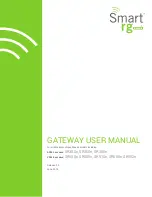
Operation
PSM-500/500L/500LT SCPC Satellite Modem
Page 3-32
PSM-500/500L/500LT - Rev. 0.91
3.6.1 L-Band BUC Control
The PSM-500L offers 3 specific features related to the control and use of an outdoor Block Up
Converter or BUC: Frequency control, power control and reference control.
Transmit Frequency Control
– When the BUC Local Oscillator or LO frequency is entered into
the
<Mod: BUC – LO Frequency>
parameter the
<Mod: IF – Frequency>
parameter entry
allows (and requires) entry of transmit frequency at the actual satellite uplink RF frequency. To
return to using L-Band IF frequencies set the BUC – LO Frequency parameter to “0”.
BUC Power Control
– When a power supply is plugged into the rear panel DIN connector, J10,
the PSM-500L uses and internal power relay to control application of power to the BUC’s transmit
input cable under front panel or remote control. The modem can also read the voltage and
current being applied to the transmit cable. The PSM-500LT has an integrated BUC power
supply.
BUC Reference Control
– The PSM-500L/LT contains a high stability 10 MHz OCXO reference
oscillator designed to provide a suitable reference signal to most BUCs. See the specifications in
Appendix A for the exact reference stability, aging, phase noise and level specifications. The
application of the reference to the transmit cable is under front panel or remote control, as
required by the BUC. Some BUCs use the 10 MHz signal to control application of power to the
final PA, removing it and going to a low power state when the 10 MHz is absent.
3.6.2 L-Band LNB Control
The PSM-500L and H offer 3 specific features related to the control and use of an outdoor Low
Noise Block Down Converter or LNB: Frequency control, power control and reference control.
Receive Frequency Control
– When the LNB Local Oscillator or LO frequency is entered into
the
<Dem: LNB – LO Frequency>
parameter the
<Dem: IF – Frequency>
parameter entry
allows (and requires) entry of receive frequency at the actual satellite downlink RF frequency. To
return to using L-Band IF frequencies set the LNB – LO Frequency parameter to “0”.
LNB Power Control
– The PSM-500L and PSM-500LT contain an internal LNB power supply
and internal power relay to control application of power to the LNB’s receive output cable under
front panel or remote control. The voltage applied can be chosen for either 18VDC or 13 VDC.
The modem can also read the voltage and current being applied to the receive cable.
LNB Reference Control
– The PSM-500L and PSM-500LT contain an internal 10 MHz reference
oscillator designed to provide a suitable signal to those LNBs requiring an external reference.
See the specifications in Appendix A for the exact reference stability, aging, phase noise and
level specifications. The application of the reference to the receive cable is under front panel or
remote control, as required by the LNB.
3.7 Data Interface Clock Options
The modem clocking and options for either VSAT or SCPC operation is discussed below:
3.7.1 VSAT Mode
A typical method of synchronization in a VSAT system is as follows. The master station reference
is used to synchronize the master station transmit data clock. The VSAT terminal receive data
clock maintains this synchronization. The VSAT terminal DTE equipment may use the receive
data clock to synchronize itself and generate the transmit data clock for input to the VSAT
modulator either directly via setting the Modulator clock source to “Receive Clock” or indirectly via
the Terminal Timing input. Alternately it may use an accurate clock to generate the transmit data
clock and input it via the Terminal Timing input.
Содержание PSM-500
Страница 1: ...M500 VSAT SCPC Satellite Modem PSM 500 PSM 500L 500LT Installation and Operation Manual Revision 0 91 ...
Страница 2: ......
Страница 32: ......
Страница 60: ......















































